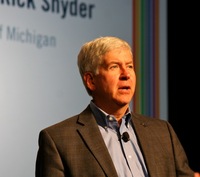C.A.R 2014 MBS Day 3 - The Gov., Toyota, Users Vs Owners
 |
2014 CENTER FOR AUTOMOTIVE RESEARCH MANAGEMENT BRIEFING SEMINARS – TRAVERSE CITY DAY 3
By Steve Purdy
TheAutoChannel.com
Michigan Bureau
Photo by Bob Benko
[Photo Caption: Michigan Governor Rick Snyder, “one tough
nerd,” addresses MBS]
 Michigan Governor Rick Snyder, “one tough nerd,” addresses MBS Photo Bob Benko |
Michigan’s increasingly shabby and outdated infrastructure has been a big issue here and limits business expansion and recruitment. Governor Snyder and the legislature have been struggling with ways to generate a few billion dollars per year to bring roads and bridges up to par, without much success. Without any specific revelations he promised progress before the end of the year. He is up for re-election this fall and is likely a shoe-in and he’ll have a legislature with both houses controlled by his own party (Republican) with plenty of lame ducks. Some kind of a tax increase is inevitable so it is more likely to be achieved by lame ducks.
We were also pleased to get from the governor an update on the International Trade Crossing a new bridge to Canada with the latter paying most of the costs. This was a huge issue during the last election season as the owner of the existing bridge spent millions trying to discredit the project. The bridge is supported by most businesses, particularly automotive, and the governor expects it will be in service by 2020. Outstanding is the decision about who will pay for the customs facility.
When his remarks were finished the governor returned to the stage to receive A State Leadership Award from the Motor and Equipment Manufacturers Association citing his “understanding and willingness to address the issues key to our industry,” and for addressing fair state tax system.” The governor’s supporters here were talking about promoting him to become a vice presidential candidate in 2014. Many think we need the nerd in Washington D.C.
Two surprises announced by the governor were that a new rail tunnel under the Detroit River is being considered that would be a real boon to automakers, and a promise that by next year Michigan will actually have a codified energy policy that will be of benefit to all business. A Michigan energy policy would be a great one-up to the Federal government.
Next up addressing the entire conference was Mr. Simon Nagata, CEO of Toyota Motor Engineering and Manufacturing North America, who began by announcing a $1 million pledge to the “Grand Bargain,” a project being orchestrated by the State of Michigan to mitigate cuts to Detroit retirees retirement and preserve the valuable collections at the Detroit Institute of Art. The DIA’s collections have been at risk of liquidation to satisfy some of the city’s debts and obligations. Mr. Nagata commented on the importance of the City of Detroit to the entire auto industry.
Mr. Nagata went on to talk about the company’s move of much of its U.S. headquarters from California to Plano, Texas. He also revealed plans for the introduction of their FCV fuel cell car and a brash new Lexus RC Sports Coupe next year. Toyota has done a masterful job over the years in developing an image of not being an outsider in the U.S. With increased manufacturing in the U.S., support of NASCAR racing, funding a plethora of local charities and having vehicles designed specifically for the domestic market they could pass for an American company. In fact, Camry is one of the most American of cars in terms of design, manufacturing content.
More browsing among the lobby booths on day three brought me to Shilo’s display of aluminum and magnesium castings and stampings. More and more parts and components need to be made from lightweight materials and they exhibited an inner door panel, oil pan, transmission parts, roof panels and other parts. Welding these materials is a special process that is done robotically or by hand. Exotic materials, like these light metals as well as engineered plastics, will make a significant contribution to meeting CAFÉ standards coming up over the next decade. How much of a contribution remains to be seen.
Another day-three panel explored interior design and how it will accommodate the many new functions demanded by future generations of buyers, or users. Interiors continue to evolve even faster than exterior design. Functionality drives design as much as aesthetics inside the car as more interactive functions need to be included to satisfy youngsters coming into the market.
Talking about “buyers” vs “users,” we’ll find in the near future small cars in big cities used by drivers intermittently on an as-needed basis rather than purchased in the traditional sense. You will probably be a subscriber to the car provision service. That will be significant for automobile sales in the future.
Best quote of the week came from an exchange between Tenneco VP, Ben Patel, discussing recruitment and retention of engineering talent and John McElroy, host of Autoline Detroit, who was moderating the panel. Patel commented that it is often good to be the “dumbest guy in the room, because you can learn more by asking more questions.” McElroy quipped, “When he said it’s good to be the dumbest guy in the room, I breathed a sigh of relief.”
©Steve Purdy, Shunpiker Productions, All Rights Reserved


